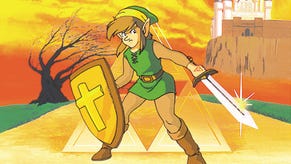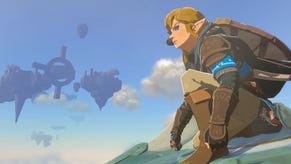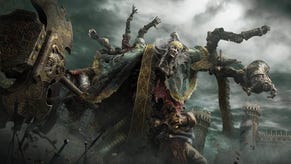Zelda: Tears of the Kingdom devs explain why it was a much bigger overhaul than you'd think
"Are we really doing this? Development is going to be chaos."
For many, The Legend of Zelda: Tears of the Kingdom is still seen as a kind of Breath of the Wild 1.5 - a half-sequel that builds on 2017's revolutionary hit but, in using the same Hyrule as its overworld, doesn't fully transform it into something new.
The Zelda developers at Nintendo would probably disagree. In a packed-out talk at GDC last week - which may go down as one of the conference's great talks of the last few years - technical director Takuhiro Dohta, lead physics engineer Takahiro Takayama, and sound programmer Junya Osada explained the complexity and sheer scale of the task at hand.
The goal, they said, was to take the two central ideas of Breath of the Wild - the notion of a "vast and seamless Hyrule" as one; the other its "multiplicative gameplay", where physics and chemistry combine to give you new solutions in-game - and expand on them. (As well as, crucially, enabling you to "dig holes," a much-memed desire of the series' legendary producer Eiji Aounouma.)
The guiding principle here was that "vast doesn't necessarily make a game fun", however, and hence that desire to expand on "multiplicative gameplay" with a new concept: "sticking two things together to make something new".
"When I first saw the prototype, I thought this was going to be a great game," Takayama said, before deadpanning, "But I also knew: this was going to be very, very difficult."
"I said to myself: are we really doing this? Development is going to be chaos," he continued. "The more I thought, the more I worried. I realised that sometimes, it's important to have the courage to push forward." Takayama then showed a montage of chaotically buggy clips from Tears of the Kingdom's early development. "As expected, the world fell apart."
Switching to Japanese to explain the more technical aspects of the challenges ahead for the studio's physics team, Takayama explained through a translator that the studio's solution to these Ganon-level collapses of the world was to create an "entirely physics-driven world" and, in doing so, "create a system where unique interactions occur, without dedicated implementation."
During development, he explained, "when we say physics-driven, what we mean is objects have mass and moments of inertia - and they can be controlled using things like velocity and acceleration". The opposite, a non-physics driven object, is referred to as a "kinematic rigid body" which in comparison is easier to implement but still visually easy to understand - something the team used quite heavily in the early stages of Tears of the Kingdom's development.
However, kinematic objects had "infinite mass", and therefore wrought havoc with actual physics-based calculations - hence objects getting caught up and stuck together, or collapsing in on themselves entirely. "Practically speaking, this meant chaos for us," Takayama said. "The clash between non-physics-driven objects and ultrahand, with a high degree of freedom, caused daily problems all over the land of Hyrule.
"It went something like this," Takayama said, acting out a conversation with his team. "I would hear something like: "It broke!" or "It went flying!", and I would respond with: "I know - we'll deal with it later! Just focus on getting the gameplay together and trying it out."
The team was in search of a solution, and "the key to that solution was in our experience developing Breath of the Wild." In the previous game, there was an issue with two cogwheels not working together properly thanks to non-physics-driven controls. The team switched them to physics-driven controls and they worked - leading the developers to make the entire world physics-driven as a whole.

Takayama gave a few more examples: the shrine gates, for one, were originally non-physics-driven, until the team discovered what happened when you put an object beneath them as they closed (as shown by a clip in the talk: that object got stuck in the gate and crumbled until it imploded.) "The physics animation would fall apart, because this was a kinematic-controlled gate." The team had to build in a special "slider constraint" to the gate and the ground, and a motor to power the gate - but there was a twist. Now, a player could break the design of shrine puzzles by using physics, putting objects beneath gates, for instance, to simply prop them open - instead of using that object for its intended purpose of weighing down a switch.
"This is precisely the kind of multiplicative gameplay we were seeking, and confirmation that making everything physics-driven was the correct approach." There were other great examples given - one of a giant rock getting tangled up with a horse and cart for instance, instead of landing on it - which made the team realise this approach had to be implemented throughout the entire game. "As a result," Takayama said, "regardless of what we do, we have a world free from self-destruction," and one "where players can freely express imagination and creativity, without destroying the world."
This also dramatically expanded that freedom available to the player - and the considerations that the developers had to keep in mind as they went. The soup pot, for instance, would tip over when placed on uneven ground. To counter this "critical problem," one proposed solution was telescopic legs that would pop out to hold it upright. In the end, the team settled on a kind of gyroscopic joint between the base of the pot and the bowl - cue lots of clips of players using soup bowls and central joints in bendy-bus-style creations. "I'm happy to say your soup is now safe," Takayama added.
There was also no dedicated vehicle system in the game - just the "individual elements" of wheels, boards, and so on - but even this led to issues that needed dedicated solutions. The team had to move away from using automatic calculations for how much things weighed, for instance, as things like boards of wood had to be made thicker to be more visible for the player.
That meant manually assigning them values - another layer of work - while even the physics of buoyancy was tinkered with to make it feel more intuitive to look at. Rather than entire objects bobbing upwards out of water with automatically-applied equal force, a single point of upwards pressure is used - making them bob and wobble more naturally.
Finally, an even more subtle layer of changes was required, which was sound. Just the same as with the game's physics, automatic calculations for volume had to be done away with, for a version that factored in the path and direction of the sound itself, with Junya Osada showing the hidden layers of voxels that made up Tears of the Kingdom's world, and where exactly a specific noise might travel across them.
The tying-in of the two came from the way those sounds combined. Just like with the physics of Tears of the Kingdom, there's also no specific vehicle noise in the game, even for set NPC vehicles like a horse-and-cart. Instead, rather than simply recording a cart and using that, there's a specific sound for each of the elements that make it up - the wheels, chains, boards, and so on - which combine together to sound just how you'd expect a cart itself would as a whole. At first, this caught the Zelda team themselves by surprise. "It's making sounds I have no memory of creating!" Osada jokingly recalled telling his director.
The same goes for paddle boats, Wright brothers-style planes, and anything else the player made in the world. And so the ultimate lesson, as the team saw it, was one of having a combined vision towards what the game would be, and working in unity to bring it about. Level designers had to consider physics in how they designed shrines, artists for how they designed pots, boards and tools, and sound designers in how sound combined and travelled through the world.
Physics and sound are two different fields, Dohta concluded, but they have a few things in common. "Both are law-based system design," and "both added another layer of complexity to interaction within the game. As a result, they each created a system that brings new discoveries - not only to players, but to us as developers."
"The concept of multiplicative gameplay was: rather than creating something fun, create a system that makes fun things happen," he said. "With Tears of the Kingdom, we aimed to create an even higher level of freedom. As a result, rather than adapting each object's movement, the physics team created a system that makes objects move. And rather than creating every sound you heard in the game, the sound team created a system that makes it sound that way."
And finally, Dohta said, "Rather than creating unique interactions, create a system that causes unique interactions to occur. I believe this was the essence of the evolution of physics and sound in Tears of the Kingdom."








